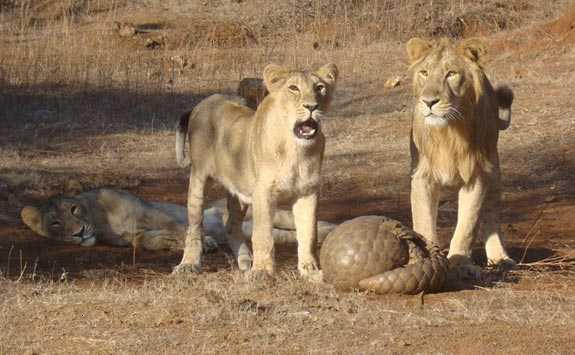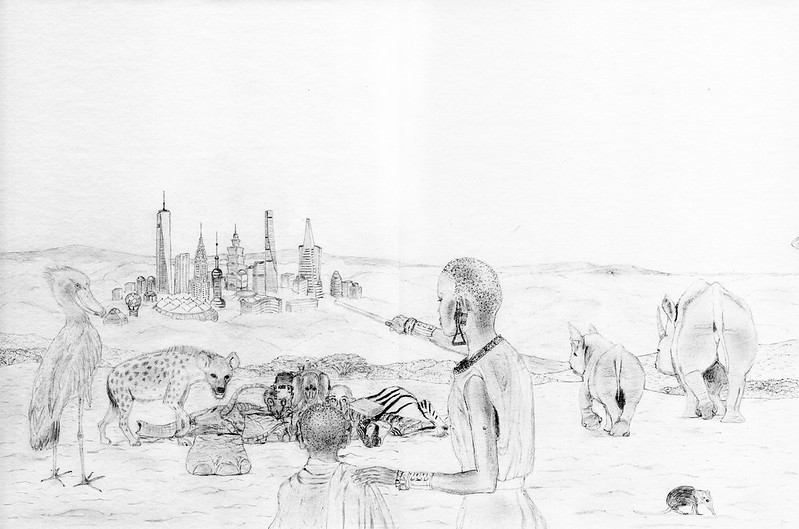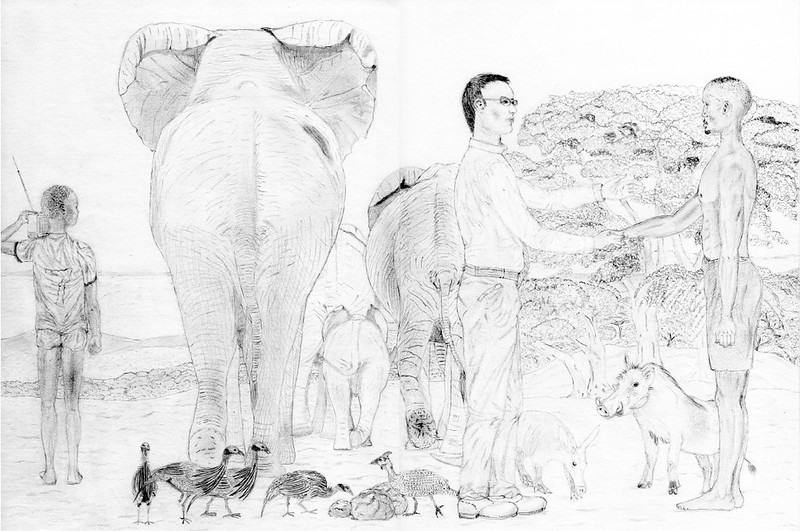Classification:
Order: Pholidota
Family: Manidea
Genus: Smutsia, Phataginus, Manis
Characteristics: A shy insect eater unwillingly crowned as the most poached mammal in the world
Tree pangolin (Manis tricuspis) in central Democratic Republic of the Congo
– Photo by Valerius Tygart
Species:
- Smutsia gigantea (Vulnerable) (previously Near Threatened) - African species
- Smutsia temminckii (Vulnerable) (previously Least Concern) - African species
- Phataginus tricuspis (Vulnerable) (previously Near Threatened) - African species
- Manis tetradactyla (Vulnerable) (previously Least Concern) - African species
- Manis crassicaudata (Endangered) (previously Least Concern) - Asian species
- Manis culionensis (Endangered) (previously Near Threatened) - Asian species
- Manis pentadactyla (Critically Endangered) (previously Endangered) - Asian species
- M. javanica (Critically Endangered) (previously Endangered) - Asian species
Population Trend:
Estimated to decrease for all 8 species
The most threatened species are the Asian species, with the Chinese and Sunda pangolins coming first, the Indian and Philippines pangolins second[1].
In the last decade, all four African species, locally hunted for meat and medicine have started replacing the Asian species in Asia. They are experiencing a steep decline too.
The IUCN estimated a 30 decrease rate over a decade in 2008 for the Philippines pangolin M. culionensis.
Chinese pangolin M. pentadactyla figures are not known precisely. However, it is thought to be the species that has dwindled the most in the last decades, especially in Vietnam and China. In areas where both Chinese pangolin and Sunda pangolin coexist, Chinese pangolin has proved to be more sensitive to hunting pressure because of its more terrestrial habits.
Main Threats:
- Poaching for food
- Poaching for traditional medicine
- Poaching for use of body parts (scales) as decoration items
- Loss of habitat for species living in forests
A mammal looking like a reptile…
The most striking feature of the pangolin is certainly the hard scales that cover its upper body. This added to its ability to roll up into a ball makes it a difficult prey to handle for big predators such as lions or leopards. However, this behaviour makes it particularly vulnerable to humans as it does not try to flee once caught.

Pangolin defending itself from lions attack, Gir Forest, Gujarat, India
– Photo by Sandip Kumar
Pangolins are sometimes referred as “scale anteaters” but this wording is misleading. Although their diet indeed includes ants and termites, pangolins are in no way related to South American anteaters and armadillos. From an evolution point of view, pangolins, despite their strange appearance are closer to the Carnivora members, as bears, tigers or seals.
All of them are discreet nocturnal mammals that mainly feed on ants and termites. Their scales are mainly made of keratin, a protein that is also found in human hairs and fingernails.
Despite having their habitat ranging from Western Africa to Southeast China, all eight living species are relatively close in appearance. Classification varies from a single genus Manis to three distinct genus Mutsia, Manis and Phataginus. Mutsia and Phataginus are sometimes referred as subgenus. I am using here a classification in 3 distinct genuses as recommended by the IUCN.
A mammal with a long history of hunting in Asia and Africa…
As many other species, pangolins are threatened by habitat loss, especially species dwelling in forests.
However, the biggest threat for pangolins is hunting for human consumption. All pangolin species have been traditionally used as bushmeat in sub-Saharan African countries[1]. As part of traditional believes, pangolin body parts have also been used for rituals and as medicines for centuries.
In Asia, pangolins face two threats: their meat is considered as a delicacy, especially in the Chinese and Vietnamese cuisines. On the contrary, there is no customs of pangolin consumption in Indonesia as these animals were traditionally considered as creatures of bad omen[2].
The equally or even greater threat for this scaly mammal is the use of its body parts, including scales for their use in traditional medicine[3], [4]. With a growing upper class eager to have access to these products, Asia has been pushing the demand for pangolins to levels never been reached before. This is the main reason why, despite being officially banned from international trade, pangolins are now being poached more than any other mammal species on Earth.
All species are protected under CITES Appendix II http://www.cites.org/fra/app/appendices.php , which means their populations has to be monitored to ensure long term survival. Only Asian species were protected by a zero quota trade as of August 2014. However, recent years have seen such a surge in the demand of pangolins that the CITES certainly needs to consider a further update in protection measures in the light of this global context.
A well established…illegal business
An investigation report from a CNN journalist published in 2014 shows that despite being forbidden by the local authorities, the pangolin trade still thrive in Vietnam. This reporter had no difficulties in finding several upper-end restaurants of Hanoi listing pangolin meat and wine on their menu cards[2].
Similarly, pangolin scales are still widely used in China and people found guilty of trading scales are rarely sentenced to the maximum penalties.
Today, legislations in Vietnam and China are theoretically in line with the CITES recommendations. However, based on IUCN’s latest update, they are not used in a way that can effectively reverse the increasing trend in illegal pangolin trade.
A business with impressive figures
Figures are impressive: According to BBC, annual seizures of pangolins and derived products correspond to around 10,000 animals[4]. This means that the total number of illegally traded pangolins is much larger. Prices for pangolin meat and scales have risen steeply in the recent years: Although pangolins are more and more difficult to find, their trade is more than ever a lucrative business.
The Chinese pangolin Manis pentadactyla population is dwindling particularly fast because of the local hunting pressure. Its population in China was estimated to be between 25,000 and 50,000 specimens in 2000 according to a national survey. Beginning of 2014, the population was thought to be only 10% of year 2000 estimation[5]. Note that this species is also present in Taiwan where it is protected. However, it is to be feared that poaching still occurs.
As a consequence of the Chinese pangolin collapse, demand has mechanically increased for other species present in Asia. In particular, the Sunda pangolin Manis javanica is now under an acute hunting pressure, while traditionally it was not hunted due to its local reputation to bring bad luck.
The Philippines pangolin Manis culionensis is also heavily poached. It is present on the island of Palawan and surrounding islands where it is protected. However, it has now become a source of income for local populations who sell them for the Chinese market.
In April 2013, the Philippines authorities seized a Chinese vessel in the Palawan island waters. It contained 10 tons of frozen pangolin meat[6].
Logically, following the collapse in the regional pangolin species traditionally hunted for the Asian markets, the last decade has seen the African species coming under increased pressure to feed the growing demand from Asia[7].
July 2014, a strong warning by the IUCN…but still no regional policies put in place.
As a direct consequence as of July 2014, the IUCN has updated the conservation status of all pangolin species:
- Temminck’s pangolin, Manis temminckii has seen its status changing from Least Concern to Vulnerable
- Phataginus tetradactyla, long tailed pangolin has seen its status changing from Least Concern to Vulnerable
- Phataginus tricuspis, the tree pangolin has seen its status changing from Near Threatened to Vulnerable
- Smutsia gigantea, the giant pangolin has seen its status changing from to Vulnerable.
- The Indian pangolin Manis crassicaudata has seen an impressive status change from Least Concern to Endangered due to a strong pressure to feed the demand in nearby Myanmar and China
- The Philippines pangolin, Manis culionensis has seen its status changing from Near Threatened to Endangered
- The Chinese pangolin Manis pentadactyla and the Sunda pangolin Manis javanica, have traditionally been poached to feed the far-eastern market (Vietnam, China). Not surprisingly, they have seen their status changing from Endangered to Critically Endangered. It is the last status before extinction in the wild.
Why the pangolins are particularly threatened:
Pangolins are not only used for medicinal purpose, pretty much like ivory, they are considered as luxury items: Consuming pangolin meat is considered as a sign of a high social status. This is not rational, and with an increasing wealthy upper class, pressure on pangolins will go on until they get extinct or people’s mentality changes.
Pangolins do not thrive nor reproduce in captivity as they most of the time die of digestive issues. With a few notable exceptions, caught animals generally do not survive more than a few months.
Zoos with the best facilities are still clueless about how to raise this little understood mammal. This means that conservation programs for pangolins are today very unlikely to secure sustainable populations in captivity.
Pangolins do not breed fast: Little is still known about their reproductive characteristics but for all species, the female bears a single offspring once a year. This makes all Manis species vulnerable with very little margin in term of population dynamics in case of increased hunting pressure. As a comparison, most rodents species bear several litters a year and are able to adapt the number of offspring to the population density. As a consequence, they can adjust their reproductive rate to food supply and hunting pressure. This is clearly not the case for pangolins.
What can I do as a simple citizen?
To give pangolins a chance, we should:
- Never use or buy any product made of pangolin body parts or organs, whether it be medicine, a food item or drink, a decorative item or a ritual item
- Report any place illegally holding pangolins in captivity, especially if there are visible signs of animal cruelty or health issue
- Minimize or avoid the consumption of products that are conflicting with pangolin’s natural habitat, if possible select products that are produced according to a chart of environmental responsibility
More information:
- http://www.pangolinsg.org/2014/06/01/pangolins-in-angolan-bushmeat-markets-2/
- http://edition.cnn.com/interactive/2014/04/opinion/sutter-change-the-list-pangolin-trafficking/index.html?hpt=hp_t5
- http://www.iucnredlist.org/details/12764/0
- http://www.bbc.co.uk/nature/26549963
- http://www.worldwatch.org/node/6198
- http://www.theguardian.com/environment/2013/apr/15/chinese-vessel-philippine-reef-illegal-pangolin-meat
- http://www.pangolinsg.org/







